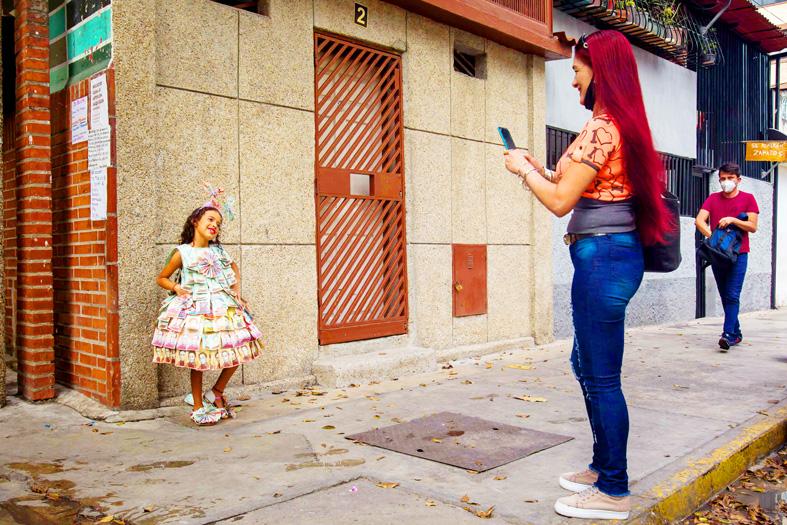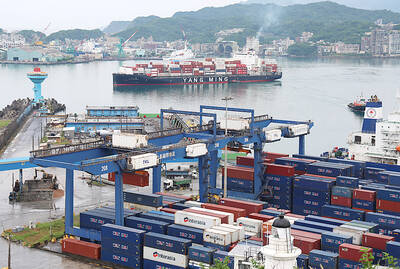Venezuela has been in recession for eight years, suffered four years of hyperinflation and endured a currency in free fall.
However, the beleaguered bolivar has, against all odds, managed to stabilize since October last year.
It is thanks to a US$2.2 billion investment by the state in a bid to slow down inflation in the South American nation.

Photo: EPA-EFE
Last year ended with inflation at 686 percent — the highest in the world.
However, that was a significant improvement on the 130,000 percent in 2018, 9,585 percent in 2019 and 3,000 percent in 2020.
According to consultancy Aristimuno Herrera & Associates, Venezuela’s central bank has injected US$2.2 billion into the internal market over the past five months.
Banned for 15 years by the government, the US dollar was once scarce and highly prized, exchanging hands on the black market for significantly more than the official exchange rate. Suffering a cashflow crisis, the Venezuelan government was forced to lift the ban in 2019.
“Offering more dollars than there is demand generates stability in the exchange rate,” Cesar Aristimuno, director at Aristimuno Herrera & Associates, told reporters.
The bank has acknowledged 29 “interventions” since October last year, although without giving details of the amounts.
In October, the bank slashed six zeros off the bolivar — making one new bolivar worth a million old ones — with the government saying this would improve faith in the local currency.
At the same time, authorities imposed a 3 percent tax on foreign currency transactions and cryptocurrencies.
“The legal tender is and will continue to be the bolivar,” Venezuelan Vice President Delcy Rodriguez, who is also the economy and finance minister, told parliament.
Since October, the exchange rate against the US dollar has moved from 4.18 bolivars to 4.32 bolivars, a depreciation of just 3.24 percent.
That compares favorably to the depreciation of 76 percent last year and more than 95 percent in each of the previous three years.
After shrinking by more than 80 percent during eight years of recession, Venezuelan GDP grew by 4 percent last year, the government claims.
“Our economy is so small that such a policy can be applied. The issue is how long will they sustain it,” said Henkel Garcia, director at Econometrica.
Some experts fear that the government is “burning” international reserves, but Aristimuno and Garcia say the US dollars have come from an increase in revenues from Venezuelan oil due to rising crude prices and a limited increase in production.
State oil company PDVSA produced more than 3 million barrels a day in 2014, but that fell to 400,000 a day six years later.
It has risen to 680,000 barrels a day, OPEC has said.
The Venezuelan central bank says it has US$10.8 billion in reserves, half the amount of 2014 and one-third of the 2007 figure.
However, the bank is including US$5 billion provided by the IMF to help mitigate effects of the COVID-19 pandemic, but which has been withheld due to questions over the 2018 re-election of Venezuelan President Nicolas Maduro in a poll widely dismissed as a fraud.
While the injection of US dollars has beneficial effects, there is “collateral damage,” Aristimuno said.
As inflation is high and the exchange rate is stable, the US dollar’s buying power is falling.
Likewise, “exports are losing their attractiveness” compared to imports, he said.
Carlos Fernandez Gallardo, president of the FEDECAMARAS employers’ federation, said he is worried.
“There is an increase in dollar costs for producers, with a pernicious effect on the consumer,” he told reporters. “What will happen if these dollars disappear?”
In 2018, the government attempted to tackle inflation by obliging banks to keep 85 percent of their reserves in the central bank in an attempt to limit the printing of money.
That served to reduce credit, which was already in free fall with the depreciating bolivar.
Venezuela is a credit minnow, with less than US$140 million last year, compared with US$14 billion in neighboring Colombia.
Aware that credit, investments and growth are intimately related, Caracas partially changed tack last month, allowing loans indexed against the US dollar under certain conditions and reducing the obligatory reserves to 73 percent.
However, the challenge remains how to promote growth while keeping inflation under control.

CHIP RACE: Three years of overbroad export controls drove foreign competitors to pursue their own AI chips, and ‘cost US taxpayers billions of dollars,’ Nvidia said China has figured out the US strategy for allowing it to buy Nvidia Corp’s H200s and is rejecting the artificial intelligence (AI) chip in favor of domestically developed semiconductors, White House AI adviser David Sacks said, citing news reports. US President Donald Trump on Monday said that he would allow shipments of Nvidia’s H200 chips to China, part of an administration effort backed by Sacks to challenge Chinese tech champions such as Huawei Technologies Co (華為) by bringing US competition to their home market. On Friday, Sacks signaled that he was uncertain about whether that approach would work. “They’re rejecting our chips,” Sacks

Taiwan’s exports soared 56 percent year-on-year to an all-time high of US$64.05 billion last month, propelled by surging global demand for artificial intelligence (AI), high-performance computing and cloud service infrastructure, the Ministry of Finance said yesterday. Department of Statistics Director-General Beatrice Tsai (蔡美娜) called the figure an unexpected upside surprise, citing a wave of technology orders from overseas customers alongside the usual year-end shopping season for technology products. Growth is likely to remain strong this month, she said, projecting a 40 percent to 45 percent expansion on an annual basis. The outperformance could prompt the Directorate-General of Budget, Accounting and

NATIONAL SECURITY: Intel’s testing of ACM tools despite US government control ‘highlights egregious gaps in US technology protection policies,’ a former official said Chipmaker Intel Corp has tested chipmaking tools this year from a toolmaker with deep roots in China and two overseas units that were targeted by US sanctions, according to two sources with direct knowledge of the matter. Intel, which fended off calls for its CEO’s resignation from US President Donald Trump in August over his alleged ties to China, got the tools from ACM Research Inc, a Fremont, California-based producer of chipmaking equipment. Two of ACM’s units, based in Shanghai and South Korea, were among a number of firms barred last year from receiving US technology over claims they have

BARRIERS: Gudeng’s chairman said it was unlikely that the US could replicate Taiwan’s science parks in Arizona, given its strict immigration policies and cultural differences Gudeng Precision Industrial Co (家登), which supplies wafer pods to the world’s major semiconductor firms, yesterday said it is in no rush to set up production in the US due to high costs. The company supplies its customers through a warehouse in Arizona jointly operated by TSS Holdings Ltd (德鑫控股), a joint holding of Gudeng and 17 Taiwanese firms in the semiconductor supply chain, including specialty plastic compounds producer Nytex Composites Co (耐特) and automated material handling system supplier Symtek Automation Asia Co (迅得). While the company has long been exploring the feasibility of setting up production in the US to address